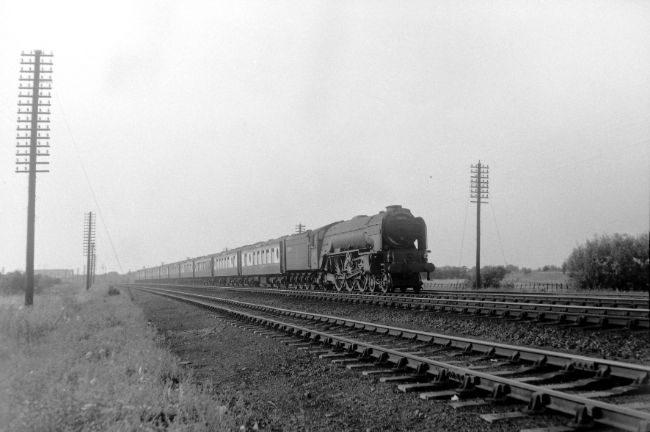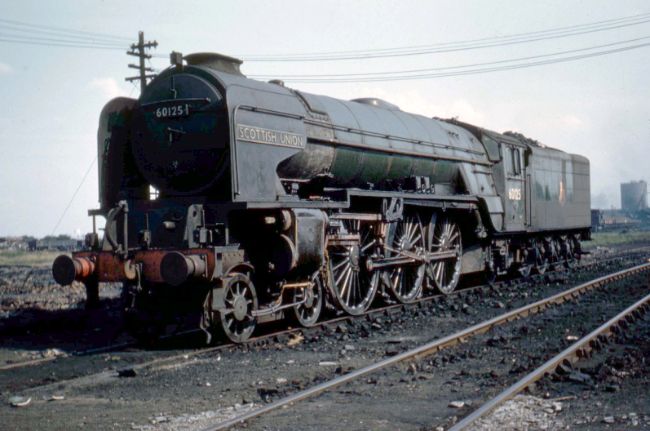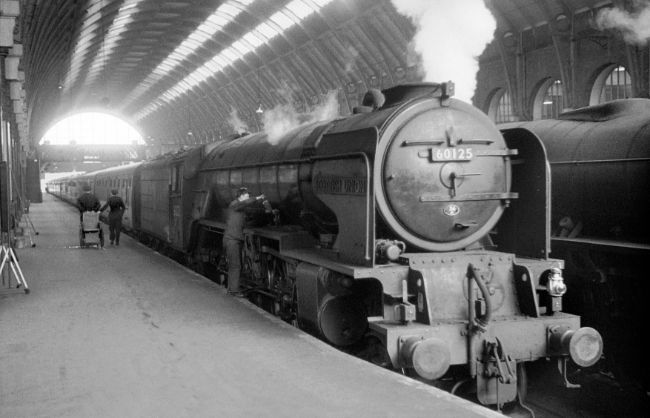Although numerically quite early in the A1 listing, No. 60125 came after well over half the class was introduced. Twenty-eight were in use already and, as Doncaster works No. 2043, it was one of four to enter traffic in April 1949. Initially allocated to Doncaster shed, it proved to be one of a number of A1s which were frequently reallocated. Its appearance was the now customary apple green with black and white lining plus a plain chimney. The first recorded trains were goods on 18th February 1950. A sighting at West Hartlepool on 12th January gives no details of the train.
After just over a year at Doncaster, No. 60125 was transferred to Copley Hill. It covered most of the length of the East Coast Main Line, noted at King’s Cross on 16th August 1950 and at Edinburgh Waverley on 10th August 1951. Several changes to the engine took place. The Flaman speed recorder was removed and a lipped chimney replaced the plain original. Repainting into BR blue occurred in January 1951, one of four that month. Well over half the class had been dealt with – 30 by the end of the previous year. At the same time it was given a name in the LNER tradition of racehorse names; Scottish Union was the winner of the 1938 St. Leger race – an appropriate choice for a Doncaster-built locomotive. Again No. 60125 was one of the later ones to be dealt with as two-thirds of the class had been named. Towards the end of 1952 Scottish Union was one of a trio fitted experimentally with a modified inside connecting rod. A repaint of two A1s into BR green in October included No. 60125 and these were the 40th and 41st so treated.

No. 60125 on the up ‘Queen of Scots’ passing Ellers Crossing in August 1953 – Peter Townend
A short-lived move to Grantham took effect on Friday 15th May 1953 but on 6th June No. 60125 was back at Copley Hill. Records from July show it passing Doncaster on the 21st with the 12:05hrs King’s Cross-Glasgow and hauling the 13:18hrs King’s Cross-Leeds the next day. However, an entry for 21st August says it failed at Doncaster with the up ‘Queen of Scots’. 2nd May 1954 saw a move back to Grantham. At the end of 1954 and up to next summer we have a number of records of Scottish Union on the down ‘Flying Scotsman’ entering Newcastle. Also, on 5th February it hauled up ‘Flying Scotsman’ from Edinburgh to Newcastle while on 6th August it brought the down train into Newcastle and returned on another namer, ‘The Heart of Midlothian’. Around 1956 the smoke box number plate and handrail were transposed.

Could this image date from the 21st August 1953 failure? Alas undated – Bill Reed
An examination of detailed records from September that year until January 1957 shows a number of East Coast trains hauled quite regularly, 05:50hrs and 06:45hrs King’s Cross-Grantham, 10:20hrs King’s Cross-Leeds, 15:10hrs and 17:25hrs King’s Cross-Newcastle, 20:20hrs King’s Cross-Edinburgh and 23:45hrs King’s Cross-Newcastle. In fact, on 16th June 1957 No. 60125 was transferred to ‘Top Shed’. As well as working as far as Newcastle it also worked off the main line, as evidenced by the 16:21hrs King’s Cross-Cambridge on 26th October. It was during 1957 that Scottish Union became the first of three A1s to reach the ‘ton’ and have this backed up by a detailed log. On a date unpublished, driver Carling of Copley Hill shed took it to 102mph on an 08:30hrs ‘extra’.

Sporting a Diagram 117 boiler, No. 60125 is seen at King’s Cross on 9th April 1962 – Mike Mountford
Reallocation back to Doncaster came on 6th January 1958. Four months afterwards the later BR crest was applied to the tender. Working are characterised by the 13:12hrs Leeds–King’s Cross on 12th April 1959 and the 13:40hrs King’s Cross-Edinburgh on 20th July the following year. A Smith-Stone speedometer was fitted onto one of the rear driving wheels. In January 1962 a Thompson diagram 117 boiler was fitted, this being characterised by the (non-banjo) dome being moved further forward. Trains that year were mostly passenger with trains to and from Leeds, a train for Hull from the capital on 17th February, and a number of references to servicing on Gateshead shed indicating runs to Newcastle. A contrast in working was shown on 7th November with the hauling of a brake van in the down direction from Newcastle at 09:30hrs followed by the 18:50hrs arrival back with the important up seed potatoes run. A local train worked was the 17:39hrs Grantham-Peterborough on 22nd November. Important passenger trains included the up ‘Yorkshire Pullman’ from Doncaster to the capital on 18th March plus the 12:10hrs King’s Cross-Newcastle for the Tyne Commission Quay on at least five occasions. Goods featured too, perhaps more so with increasing dieselisation. A class 7 goods was worked from Tyne yard to Tweedmouth on 3rd October while eight days later an up light engine working to King’s Cross was followed by down class 4 goods.
After a life working along the main line and to West Yorkshire No. 60125 was withdrawn on 4th July 1964. It was the 18th to be condemned. It had been fitted with eight different boilers. The following month Scottish Union was sold for scrap to Cox & Danks of Wadsley Bridge and it was last noted on the 23rd lying withdrawn at Doncaster shed.
This history was compiled by Phil Champion based on a database compiled by Tommy Knox and with reference to the RCTS book “Locomotives of the LNER Part 2A” as background. Revised and updated by Graham Langer, April 2020.